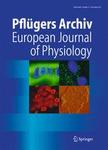版权所有:内蒙古大学图书馆 技术提供:维普资讯• 智图
内蒙古自治区呼和浩特市赛罕区大学西街235号 邮编: 010021

作者机构:Florey Inst Neurosci & Mental Hlth Ion Channels & Human Dis Lab 30 Royal Parade Parkville Vic 3052 Australia
出 版 物:《PFLUGERS ARCHIV-EUROPEAN JOURNAL OF PHYSIOLOGY》 (Pflug. Arch. Eur. J. Physiol.)
年 卷 期:2019年第471卷第1期
页 面:15-42页
核心收录:
学科分类:0710[理学-生物学] 07[理学] 071003[理学-生理学]
基 金:Swiss National Science Foundation Hartmann Muller-Stiftung (University of Zurich)
主 题:Phosphate cotransport Electrophysiology Fluorometry Kinetics Structure-function
摘 要:The expression cloning some 25years ago of the first member of SLC34 solute carrier family, the renal sodium-coupled inorganic phosphate cotransporter (NaPi-IIa) from rat and human tissue, heralded a new era of research into renal phosphate handling by focussing on the carrier proteins that mediate phosphate transport. The cloning of NaPi-IIa was followed by that of the intestinal NaPi-IIb and renal NaPi-IIc isoforms. These three proteins constitute the main secondary-active Na+-driven pathways for apical entry of inorganic phosphate (P-i) across renal and intestinal epithelial, as well as other epithelial-like organs. The key role these proteins play in mammalian P-i homeostasis was revealed in the intervening decades by numerous in vitro and animal studies, including the development of knockout animals for each gene and the detection of naturally occurring mutations that can lead to P-i-handling dysfunction in humans. In addition to characterising their physiological regulation, research has also focused on understanding the underlying transport mechanism and identifying structure-function relationships. Over the past two decades, this research effort has used real-time electrophysiological and fluorometric assays together with novel computational biology strategies to develop a detailed, but still incomplete, understanding of the transport mechanism of SLC34 proteins at the molecular level. This review will focus on how our present understanding of their molecular mechanism has evolved in this period by highlighting the key experimental findings.